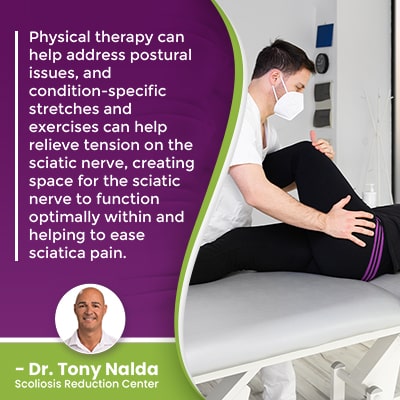Use These Sciatica Stretches for Sciatica Pain Relief

Sciatica stretches can help with flare ups, during which time symptoms intensify, before abating again for intervals that vary from patient to patient. The sciatic nerve is the largest and thickest nerve in the body; its pathway is extensive, and if it's compressed, pinched, and/or impinged anywhere along its route, sciatic nerve pain is the result.
Many consider sciatica to be a condition, but it's actually not, and while sciatica stretches can help provide short-term pain relief, nerves don't always like to be stretched, and long-term pain management is only possible through treatment that addresses the underlying cause of the sciatic nerve pain.
To better understand the nature of sciatic nerve pain, let's touch on some basic spinal anatomy.
Table of Contents
The Spine and the Sciatic Nerve
In a healthy spine, its natural curves and alignment are in place, and this means its vertebrae (bones) are stacked on top of one another in a straight and neutral alignment.
An intervertebral disc sits between each pair of adjacent vertebrae, and these discs are key to spinal health and function; they give the spine structure (adjacent vertebrae attach to the disc in between), flexibility, cushioning to prevent friction during movement, and act as the body's shock absorbers.
When it comes to general spinal degeneration, its most often the discs that are the first spinal structures to feel the effects; in fact, disc degeneration is a contributing factor in the development of a number of spinal conditions/issues.
The spinal cord runs through a hollow tunnel formed by the vertebral bodies, and the cord consists of the 31 pairs of spinal nerves; it's because the spine and brain work in tandem to form the central nervous system (CNS) that spinal conditions can produce such a myriad of symptoms felt throughout the body.
The central nervous system is a vast communication network that facilitates brain-body communication.
There are three main spinal sections: the cervical spine (neck), the thoracic spine (middle/upper back), and the lumbar spine (lower back).
And where does the sciatic nerve start?
The Sciatic Nerve
The sciatic nerve is the longest and thickest nerve in the body, and it starts in the lumbar spine and extends down the back of the buttock, back of the leg, and into the foot.
In most cases, sciatic nerve pain is felt down the body's left side, but it can affect the right side, and rarely affects both.
The sciatic nerve is known as a mixed nerve because it contains both motor and sensory fibers, which is why sciatic nerve compression can affect both motion and sensation.
As is the case with most spinal conditions, the area of the body located the closest to the affected spinal section is the most likely to feel its direct effects, so if the sciatic nerve is exposed to uneven pressure, the main effects are going to be felt by the lower body.
So if the sciatic nerve is exposed to uneven pressure (compression), it can become inflamed and irritated, and if there is less room for it to function within, it can become pinched and impinged, and this can cause a variety of symptoms:
- Burning pain felt anywhere along the sciatic nerve's pathway
- Electric shock-like shooting pains throughout the lower body
- Tingling and/or numbness sensations
- Lower back pain
- Reduced range of motion in the lower back
- Muscle weakness
- Issue with bowel or bladder control (severe cases)
Sciatic nerve pain can range from mild and intermittent to chronic and debilitating. Many people experience flare ups, during which time symptoms intensify, and frequency and severity will depend on a number of patient factors such as what's causing the sciatic nerve pain.
Some peoples' sciatica pain resolves in a matter of weeks, but cases that are caused by the presence of another spinal condition/issue, such as lumbar spinal stenosis or a herniated disc, will require proactive treatment for sustainable long-term results; for those looking for some short-term pain relief, sciatica stretching exercises can help.
Sciatic Nerve Stretches
 It's important to understand that nerves aren't like muscles; they don't always like to be stretched. Sometimes, when nerve pain is an issue, stretching the affected nerve can irritate it further.
It's important to understand that nerves aren't like muscles; they don't always like to be stretched. Sometimes, when nerve pain is an issue, stretching the affected nerve can irritate it further.
When it comes to sciatic nerve stretches for pain relief, we're talking about stretching the spinal section and muscles that surround the sciatic nerve as this can help reduce pain by keeping the spine strong and flexible, along with its surrounding muscles that support and stabilize the spine.
Physical therapy can help address postural issues and condition-specific stretches and exercises can help relieve tension on the sciatic nerve, creating space for the sciatic nerve to function optimally within and helping to ease sciatica pain.
Sciatic Nerve Glide Exercise
The sciatic nerve glide exercise is a seated exercise that can help address sciatic pain by relaxing and desensitizing the sciatic nerve; when the nerve is in this state, it's less likely to be inflamed and/or irritated, which is the cause of sciatica pain.
Steps for Performing the Sciatic Nerve Glide Exercise
1) While sitting up straight in a chair, straighten one knee, and keep the other foot flat on the floor
2) Slowly bend the ankle in towards the body; the toes should be pointing up and back
3) Continue bending the ankle back and forth, with the toes away from the body, and then pulled back in towards the body
4) Pump the ankle in this manner, up and down, for approximately 15 to 20 minutes, and then switch to the other leg
Performing the sciatic nerve glide stretch with each leg for three rounds, twice a day, can help keep the sciatic nerve relaxed and less vulnerable to irritation.
Standing Piriformis Stretch
The piriformis muscle is a small but powerful muscle that affects a lot of lower-body movement.
The piriformis is involved in moving the hips, upper legs, and the feet away from the body, and it also covers the sciatic nerve.
The piriformis enables moving the hips, upper legs, and feet away from the body. The piriformis also covers the sciatic nerve that runs from your lower back and down towards your legs.
Steps for Performing the Standing Piriformis Stretch
1) While in a standing position, place the leg that's painful (often the left leg) over the knee of the opposite leg
2) Lower the hips to an approximate 45-degree angle until they are aligned with the ground while bending the standing leg as much as is needed
3) While hinging forward at the waist, reach the arms down towards the ground while keeping the spine in a straight and aligned position
4) Hold the pose for approximately 30 to 60 seconds
5) Switch legs and repeat
Standing Hamstring Stretch
 The hamstring muscles are a group of 3 large muscles in the back of the thigh that extend from the pelvis and the knee, and they help with bending the knees and extending the hip.
The hamstring muscles are a group of 3 large muscles in the back of the thigh that extend from the pelvis and the knee, and they help with bending the knees and extending the hip.
If the hamstring muscles are tight, it can make the lower back tight, and as the sciatic nerve starts in the lumbar spine, tight hamstring muscles can irritate the lower back and its nerves within, causing pain in the knee, hip, and ankle.
Stretching the hamstring muscles can help relieve pressure on the sciatic nerve root to help with pain relief.
Steps for Performing a Standing Hamstring Stretch
1) With a chair in front, extend the right leg and place the right foot at hip level on the seat of the chair
2) Flex the foot to ensure the toes and legs are straight
3) Gently pull the body forward toward the elevated foot; the deeper the bend, the deeper the stretch
4) Then release the hip on the raised-leg side downward, rather than lifting it upwards
5) Hold the position for approximately 30 seconds and repeat with the other side
Conclusion
As nerves don't always like to be stretched, consulting with a physical therapist on the types of exercises and stretches that can help with sciatica symptoms is recommended.
When it comes to reducing pressure on the sciatic nerve, this can mean strengthening the spine and its surrounding muscles, and a standing hamstring stretch, piriformis stretch, and the sciatic nerve glide exercise can help.
Keeping the spine straight and aligned means it's not compressing its surrounding muscles and nerves, and with most spinal conditions/issues, it's the area of the body located closest to the affected spinal section that is going to feel the majority of its direct effects; hence why sciatic nerve compression and/or irritation is largely felt in the left hip, buttock, left thigh, left leg, left knee, and left foot.
The sciatic nerve is the largest in the body with an extensive pathway; when it comes to short-term sciatic pain relief, stretches and exercises can help, but when the sciatica is caused by the presence of a larger spinal condition/issue such as scoliosis, lumbar spinal stenosis, and/or degenerative disc disease, the underlying cause has to be addressed.
Here at the Scoliosis Reduction Center, once the underlying cause of sciatic nerve pain is determined, through the application of proactive conservative treatment, a customized treatment plan is crafted.
Dr. Tony Nalda
DOCTOR OF CHIROPRACTIC
After receiving an undergraduate degree in psychology and his Doctorate of Chiropractic from Life University, Dr. Nalda settled in Celebration, Florida and proceeded to build one of Central Florida’s most successful chiropractic clinics.
His experience with patients suffering from scoliosis, and the confusion and frustration they faced, led him to seek a specialty in scoliosis care. In 2006 he completed his Intensive Care Certification from CLEAR Institute, a leading scoliosis educational and certification center.
About Dr. Tony Nalda
 Ready to explore scoliosis treatment? Contact Us Now
Ready to explore scoliosis treatment? Contact Us Now





